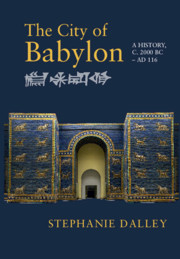Book contents
- The City of Babylon
- The City of Babylon
- Copyright page
- Contents
- Illustrations and Maps
- Preface
- Conventions
- Timeline
- Written Languages and Their Scripts
- 1 Land and Peoples
- 2 Discoveries and Excavations
- 3 First Kings to the End of the Great Rebellion, c. 1894–c. 1732
- 4 Law, Education, Literature, and the Path to Supremacy
- 5 From the Great Rebellion to the End of the First Dynasty, c. 1732–1592
- 6 The Next Six Centuries
- 7 In the Shadow of Assyria, 978–625
- 8 Empire
- 9 From the Death of Nebuchadnezzar II to the Death of Cambyses, 561–522
- 10 Darius I to Alexander, and Seleucid to Parthian Rule
- 11 First Parthian Conquest, 141 BC, to the Visit of Trajan in AD 116
- Appendix: Genesis 14:1–16 and Possible Links with Foreign Rulers Early in the Reign of Hammurabi
- Bibliography
- Index
5 - From the Great Rebellion to the End of the First Dynasty, c. 1732–1592
Published online by Cambridge University Press: 23 June 2021
- The City of Babylon
- The City of Babylon
- Copyright page
- Contents
- Illustrations and Maps
- Preface
- Conventions
- Timeline
- Written Languages and Their Scripts
- 1 Land and Peoples
- 2 Discoveries and Excavations
- 3 First Kings to the End of the Great Rebellion, c. 1894–c. 1732
- 4 Law, Education, Literature, and the Path to Supremacy
- 5 From the Great Rebellion to the End of the First Dynasty, c. 1732–1592
- 6 The Next Six Centuries
- 7 In the Shadow of Assyria, 978–625
- 8 Empire
- 9 From the Death of Nebuchadnezzar II to the Death of Cambyses, 561–522
- 10 Darius I to Alexander, and Seleucid to Parthian Rule
- 11 First Parthian Conquest, 141 BC, to the Visit of Trajan in AD 116
- Appendix: Genesis 14:1–16 and Possible Links with Foreign Rulers Early in the Reign of Hammurabi
- Bibliography
- Index
Summary
Samsu-iluna’s suppression of the Great Rebellion did not cause long-term harm to Babylonia. The succession of kings remained stable, defeated cities were not totally destroyed despite the rhetoric of victory. Southern cities adopted organic writing materials, so their activities are unknown to us. An archive that began in the reign of Hammurabi’s father continued to the end of this dynasty. Samsu-iluna’s huge project to divert floodwater from the Euphrates to protect Babylon was extended after the rebellion. Edicts for debt remission and to regulate trade continued to be issued. The use of Kassite and Elamite militias to garrison forts, Kish as a military base for Babylon, and a campaign to the north of Assyria, indicate organization and strength when the Assyrian trading colonies in Anatolia came to an end. Subsequent kings in Babylon won their own fame: Abi-eshuh for his literary works, Ammi-ditana for military achievements, Ammi-saduqa for being acknowledged as a god in Syria and Anatolia, for beating back rebels in the Sealand, for creating wonderful statues, and for recording astronomical observations. The last king of the dynasty enjoyed a long reign but came under pressure from the Hittites and Sealanders.
Keywords
- Type
- Chapter
- Information
- The City of BabylonA History, c. 2000 BC – AD 116, pp. 106 - 131Publisher: Cambridge University PressPrint publication year: 2021

